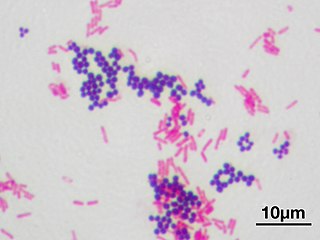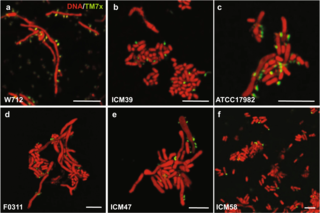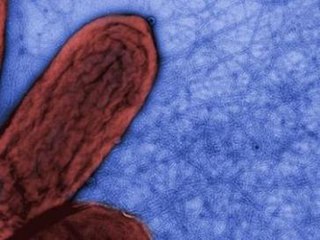Related Research Articles

In microbiology and bacteriology, Gram stain, is a method of staining used to classify bacterial species into two large groups: gram-positive bacteria and gram-negative bacteria. The name comes from the Danish bacteriologist Hans Christian Gram, who developed the technique in 1884.

In bacteriology, gram-positive bacteria are bacteria that give a positive result in the Gram stain test, which is traditionally used to quickly classify bacteria into two broad categories according to their type of cell wall.

Sphingomonadaceae are a gram-negative bacterial family of the Alphaproteobacteria. An important feature is the presence of sphingolipids in the outer membrane of the cell wall. The cells are ovoid or rod-shaped. Others are also pleomorphic, i.e. the cells change the shape over time. Some species from Sphingomonadaceae family are dominant components of biofilms.

The bacteria capsule is a large structure common to many bacteria. It is a polysaccharide layer that lies outside the cell envelope, and is thus deemed part of the outer envelope of a bacterial cell. It is a well-organized layer, not easily washed off, and it can be the cause of various diseases.

Mycobacterium smegmatis is an acid-fast bacterial species in the phylum Actinomycetota and the genus Mycobacterium. It is 3.0 to 5.0 µm long with a bacillus shape and can be stained by Ziehl–Neelsen method and the auramine-rhodamine fluorescent method. It was first reported in November 1884 by Lustgarten, who found a bacillus with the staining appearance of tubercle bacilli in syphilitic chancres. Subsequent to this, Alvarez and Tavel found organisms similar to that described by Lustgarten also in normal genital secretions (smegma). This organism was later named M. smegmatis.

Carbol fuchsin, carbol-fuchsin, carbolfuchsin, or Castellani's paint is a mixture of phenol and basic fuchsin that is used in bacterial staining procedures. It is commonly used in the staining of mycobacteria because it has an affinity for the mycolic acids found in their cell membranes.

Filamentation is the anomalous growth of certain bacteria, such as Escherichia coli, in which cells continue to elongate but do not divide. The cells that result from elongation without division have multiple chromosomal copies.
The bacterium, despite its simplicity, contains a well-developed cell structure which is responsible for some of its unique biological structures and pathogenicity. Many structural features are unique to bacteria and are not found among archaea or eukaryotes. Because of the simplicity of bacteria relative to larger organisms and the ease with which they can be manipulated experimentally, the cell structure of bacteria has been well studied, revealing many biochemical principles that have been subsequently applied to other organisms.

Bacteria are ubiquitous, mostly free-living organisms often consisting of one biological cell. They constitute a large domain of prokaryotic microorganisms. Typically a few micrometres in length, bacteria were among the first life forms to appear on Earth, and are present in most of its habitats. Bacteria inhabit soil, water, acidic hot springs, radioactive waste, and the deep biosphere of Earth's crust. Bacteria play a vital role in many stages of the nutrient cycle by recycling nutrients and the fixation of nitrogen from the atmosphere. The nutrient cycle includes the decomposition of dead bodies; bacteria are responsible for the putrefaction stage in this process. In the biological communities surrounding hydrothermal vents and cold seeps, extremophile bacteria provide the nutrients needed to sustain life by converting dissolved compounds, such as hydrogen sulphide and methane, to energy. Bacteria also live in symbiotic and parasitic relationships with plants and animals. Most bacteria have not been characterised and there are many species that cannot be grown in the laboratory. The study of bacteria is known as bacteriology, a branch of microbiology.
Aerobic anoxygenic phototrophic bacteria (AAPBs) are Alphaproteobacteria and Gammaproteobacteria that are obligate aerobes that capture energy from light by anoxygenic photosynthesis. Anoxygenic photosynthesis is the phototrophic process where light energy is captured and stored as ATP. The production of oxygen is non-existent and, therefore, water is not used as an electron donor. They are widely distributed marine bacteria that may constitute over 10% of the open ocean microbial community. They can be particularly abundant in oligotrophic conditions where they were found to be 24% of the community. Aerobic anoxygenic phototrophic bacteria are photoheterotrophic (phototroph) microbes that exist in a variety of aquatic environments. Most are obligately aerobic, meaning they require oxygen to grow. One aspect of these bacteria is that they, unlike other similar bacteria, are unable to utilize BChl (bacteriochlorophyll) for anaerobic growth. The only photosynthetic pigment that exists in AAPB is BChl-a. Anaerobic phototrophic bacteria, on the contrary, can contain numerous species of photosynthetic pigments like bacteriochlorophyll-a. These bacteria can be isolated using carotenoid presence and medias containing organic compounds. Predation, as well as the availability of phosphorus and light, have been shown to be important factors that influence AAPB growth in their natural environments. AAPBs are thought to play an important role in carbon cycling by relying on organic matter substrates and acting as sinks for dissolved organic carbon. There is still a knowledge gap in research areas regarding the abundance and genetic diversity of AAPB, as well as the environmental variables that regulate these two properties.

Bacterial phyla constitute the major lineages of the domain Bacteria. While the exact definition of a bacterial phylum is debated, a popular definition is that a bacterial phylum is a monophyletic lineage of bacteria whose 16S rRNA genes share a pairwise sequence identity of ~75% or less with those of the members of other bacterial phyla.

Saccharibacteria, formerly known as TM7, is a major bacterial lineage. It was discovered through 16S rRNA sequencing.

Geobacter sulfurreducens is a gram-negative metal and sulphur-reducing proteobacterium. It is rod-shaped, aerotolerant anaerobe, non-fermentative, has flagellum and type four pili, and is closely related to Geobacter metallireducens. Geobacter sulfurreducens is an anaerobic species of bacteria that comes from the family of bacteria called Geobacteraceae. Under the genus of Geobacter, G. sulfurreducens is one out of twenty different species. The Geobacter genus was discovered by Derek R. Lovley in 1987. G. sulfurreducens was first isolated in Norman, Oklahoma, USA from materials found around the surface of a contaminated ditch.
Vibrio coralliilyticus is a Gram-negative, rod-shaped bacterium. It has a polar flagellum that is used for motility and has been shown to be critical for its virulence to corals. It is a versatile pathogen, impacting several marine invertebrates including Pocillopora damicornis corals, both the Pacific and Eastern Oyster's larvae and some vertebrates such as the rainbow trout. It is a bacterium of considerable interest given its direct contribution to temperature dependent coral bleaching as well as its impacts on aquaculture where it can contribute to significant mortalities in larval oyster hatcheries. There are several known virulent strains, which appear on both the Pacific and Atlantic Coasts of the United States. After its initial discovery some strains were incorrectly classified as Vibrio tubiashii including the RE22 and RE98 strains but were later reclassified as Vibrio coralliilyticus.

Methanosarcina barkeri is the most fundamental species of the genus Methanosarcina, and their properties apply generally to the genus Methanosarcina. Methanosarcina barkeri can produce methane anaerobically through different metabolic pathways. M. barkeri can subsume a variety of molecules for ATP production, including methanol, acetate, methylamines, and different forms of hydrogen and carbon dioxide. Although it is a slow developer and is sensitive to change in environmental conditions, M. barkeri is able to grow in a variety of different substrates, adding to its appeal for genetic analysis. Additionally, M. barkeri is the first organism in which the amino acid pyrrolysine was found. Furthermore, two strains of M. barkeri, M. b. Fusaro and M. b. MS have been identified to possess an F-type ATPase along with an A-type ATPase.

Bioluminescent bacteria are light-producing bacteria that are predominantly present in sea water, marine sediments, the surface of decomposing fish and in the gut of marine animals. While not as common, bacterial bioluminescence is also found in terrestrial and freshwater bacteria. These bacteria may be free living or in symbiosis with animals such as the Hawaiian Bobtail squid or terrestrial nematodes. The host organisms provide these bacteria a safe home and sufficient nutrition. In exchange, the hosts use the light produced by the bacteria for camouflage, prey and/or mate attraction. Bioluminescent bacteria have evolved symbiotic relationships with other organisms in which both participants benefit close to equally. Another possible reason bacteria use luminescence reaction is for quorum sensing, an ability to regulate gene expression in response to bacterial cell density.

Poribacteria are a candidate phylum of bacteria originally discovered in the microbiome of marine sponges (Porifera). Poribacteria are Gram-negative primarily aerobic mixotrophs with the ability for oxidative phosphorylation, glycolysis, and autotrophic carbon fixation via the Wood – Ljungdahl pathway. Poribacterial heterotrophy is characterised by an enriched set of glycoside hydrolases, uronic acid degradation, as well as several specific sulfatases. This heterotrophic repertoire of poribacteria was suggested to be involved in the degradation of the extracellular sponge host matrix.

James Ivor Prosser is a Professor in Environmental Microbiology in the Institute of Biological and Environmental Sciences at the University of Aberdeen.
Bacterioplankton counting is the estimation of the abundance of bacterioplankton in a specific body of water, which is useful information to marine microbiologists. Various counting methodologies have been developed over the years to determine the number present in the water being observed. Methods used for counting bacterioplankton include epifluorescence microscopy, flow cytometry, measures of productivity through frequency of dividing cells (FDC), thymidine incorporation, and leucine incorporation.
Lone Gram is Danish microbiologist known for her work in bacterial physiology, microbial communication, and biochemicals that originate from bacterial cultures. She is an elected member of the Royal Danish Academy of Sciences and Letters and has received the Order of the Dannebrog.
References
- ↑ Lee, H.; Woo, E.R.; Lee, D.G. (2015). "Glochidioboside kills pathogenic bacteria by membrane perturbation". Current Microbiology. 71 (1): 1–7. doi:10.1007/s00284-015-0807-9. PMID 25820208. S2CID 14011127.
- ↑ Gaforio, J.J.; Serrano, M.J.; Ortega, E.; Algarra, I.; Alvarez de Cienfuegos, G. (2002). "Use of SYTOX green dye in the flow cytometric analysis of bacterial phagocytosis". Cytometry. 48 (2): 93–96. doi:10.1002/cyto.10107. ISSN 0196-4763. PMID 12116370.
- ↑ Lebaron, P.; Catala, P.; Parthuisot, N. (July 1998). "Effectiveness of SYTOX Green Stain for Bacterial Viability Assessment". Applied and Environmental Microbiology. 64 (7): 2697–2700. doi:10.1128/AEM.64.7.2697-2700.1998. PMC 106447 . PMID 9647851.
- ↑ Bakshi, Somenath; Choi, Heejun; Rangarajan, Nambirajan; Barns, Kenneth J.; Bratton, Benjamin P.; Weisshaar, James C. (2014-08-15). Parales, R. E. (ed.). "Nonperturbative Imaging of Nucleoid Morphology in Live Bacterial Cells during an Antimicrobial Peptide Attack". Applied and Environmental Microbiology. 80 (16): 4977–4986. doi:10.1128/AEM.00989-14. ISSN 0099-2240. PMC 4135745 . PMID 24907320.